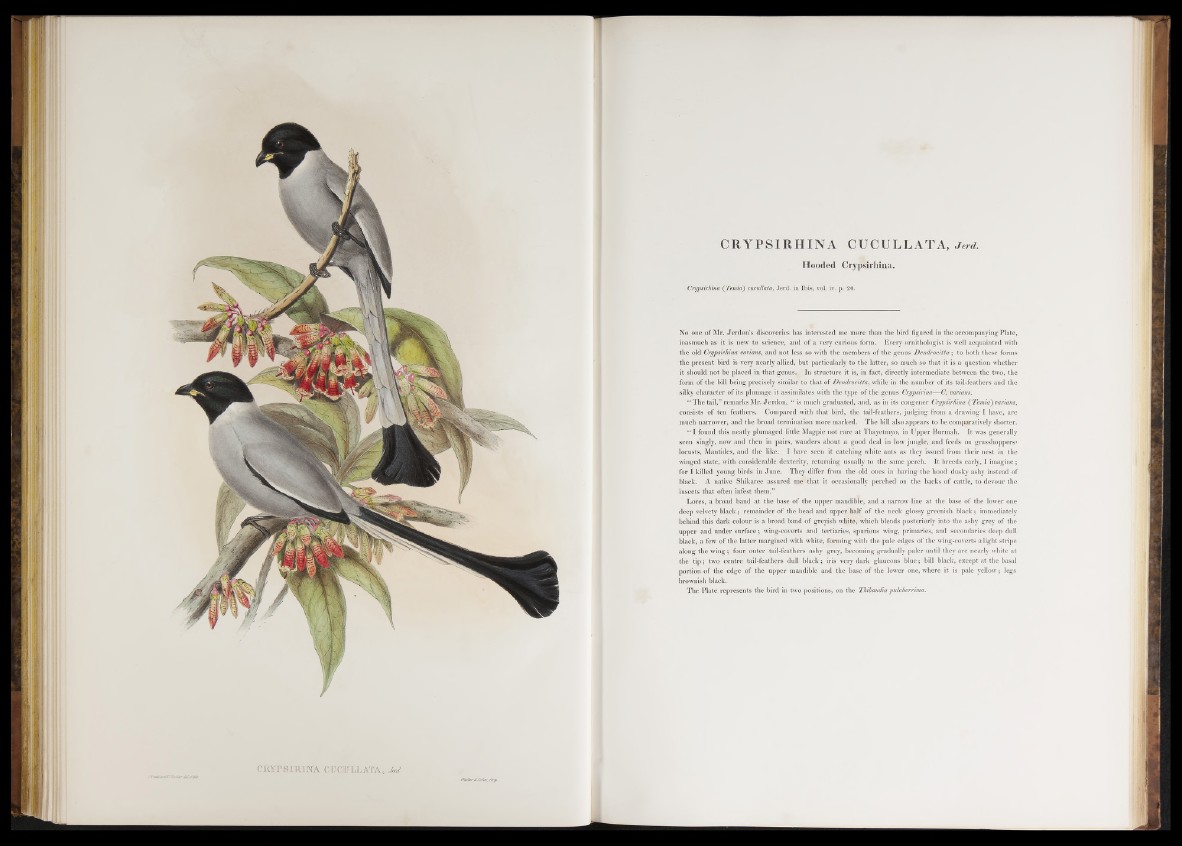
CRYPSIRINÀ CTTCTTJLLATA, M .
CRYPSIRHINA CUCULLATA, J erd .
Hooded Crypsirhina.
Crypsirhina (Temia) cuculiata, Jerd. in Ibis, voi. iv. p. 20.
No one of Mr. Jerdon’s discoveries has interested me more than the bird figured in the accompanying Plate,
inasmuch as it is new to science, and of a very curious form. Every ornithologist is well acquainted with
the old Crypsirhina varians, and not less so with the members of the genus Dendrocitta; to both these forms
the present bird is very nearly allied, but particularly to the latter, so much so that it is a question whether
it should not be placed in that genus. In structure it is, in fact, directly intermediate between the two, the
form of the bill being precisely similar to that of Dendrocitta, while in the number of its tail-feathers and the
silky character of its plumage it assimilates with the type o f the genus Crypsirina— C. varians.
“ The tail,” remarks Mr. Jerdon, “ is much graduated, and, as in its congener Crypsirhina (Temia') varians,
consists of ten feathers. Compared with that bird, the tail-feathers, judging from a drawing I have, are
much narrower, and the broad termination more marked. The bill also appears to be comparatively shorter.
“ I found this neatly plumaged little Magpie not rare a t Thayetmyo, in Upper Burmah. It was generally
seen singly, now and then in pairs, wanders about a good deal in low jungle, and feeds on grasshoppers»
locusts, Mantides, and the like. I have seen it catching white ants as they issued from their nest in the
winged state, with considerable dexterity, returning usually to the same perch. It breeds early, I imagine;
for I killed young birds in June. They differ from the old ones in having the hood dusky ashy instead of
black. A native Shikaree assured me that it occasionally perched on the backs of cattle, to devour the
insects that often infest them.”
Lores, a broad band at the base o f the upper mandible, and a narrow line at the base o f the lower one
deep velvety black; remainder of the head and upper half o f the neck glossy greenish black; immediately
behind this dark colour is a broad band of greyish white, which blends posteriorly into the ashy grey of the
upper and under surface; wing-coverts and tertiaries, spurious wing, primaries, and secondaries deep dull
black, a few of the latter margined with white, forming with the pale edges of the wing-coverts a light stripe
along the wing; four outer tail-feathers ashy grey, becoming gradually paler until they are nearly white at
the t ip ; two centre tail-feathers dull black; iris very dark glaucous blue; bill black, except a t the basal
portion of the edge o f the upper mandible and the base of the lower one, where it is pale yellow; legs
brownish black.
The Plate represents the bird in two positions, on the Thibaudia pulcherrima.